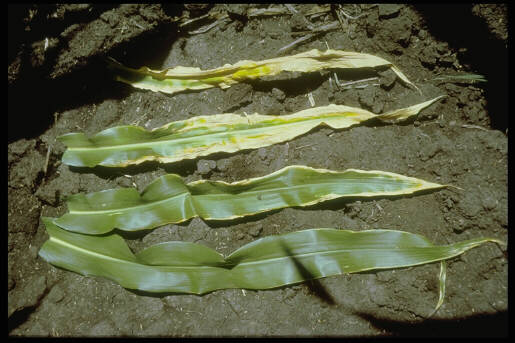

Potassium is the "universal cation" in biological systems. Only one oxidation state, soluble with all biologically significant anions (except one!) and at all pH values. Nontoxic, even at soil and plant levels far in excess of minimum requirements for optimum growth. Phloem-mobile.
See "The structure of the potassium channel: molecular basis of K+ conduction and selectivity", D.A. Doyle et al., 1998, Science 280:69-77. X-ray analysis of the K-channel shows a selectivity filter only 12 Å long, consisting of carbonyls from G-Y-G sequences of four identical subunits. Also be sure to visit the interactive 3-D computer model of the K-channel at the "Virtual Museum of Minerals and Molecules" - a free browser plug-in must be installed to see the displays...instructions on site!
K Inputs to soil:
K Outputs from soil:
Soluble K+, ~0.1% of total soil K, does not form any chelates, complexes, or ion pairs in the soil solution. Typical concentrations soil solutions in alfisols and mollisols is 150 µM, which is equivalent to 6 mg/L. In humid soils, the typical values are even lower.
Exchangeable K, 0.1 to 2% of total soil K, is the major bioavailable form of K in the soil. Cation exchange capacities of soils typically range from 5 to 60 cmol(+) kg-1 (SI, =5 to 60 milliequivalents/100grams), and K is typically 1 to 3% of the total CEC, rarely more. There is rapid equilibrium between soluble K and exchangeable K which can be described by the Gapon equation:

where kG is the Gapon exchange coefficient (not quite a constant), exchangeable cations are indicated with "ex" and given in units of charge such as cmol(+) kg-1 (SI, = milliequivalents/100g) and soluble cations are indicated as "sol" in units of mol(+) m-3 (SI, = milliequivalents/L). Addition of water-soluble K as fertilizers or depletion of K by plant uptake forces readjustment of the soluble and exchangeable K, Ca, and Mg until equilibrium is reestablished. (Incidentally, there is no analytical solution to this equation, only numerical approximations to solve it!). The ratio of exchangeable cations is often called the "Exchangeable Potassium Ration" (EPR), and the ratio of soluble cations, "Potassium Adsorption Ratio" (PAR), analogous to the ESR and SAR terminology used for Na+ exchange.
Depletion of soil solution K at the root-soil interface causes readjustment of the exchangeable K to satisfy the equilibrium equation described above, releasing more K into solution, thereby buffering soluble K against depletion. The exchangeable K is also depleted and diffusion causes an ever widening zone of K depletion to spread out from the root surface, leading to the development of a rhizosphere several millimeters in radius.
Fixed K, 1-10% of total K, is somewhat less well defined, although fairly easy to imagine. High levels of soluble and exchangeable K, particularly with wetting and drying cycles, will cause K+ to dehydrate at the internal surfaces of 2:1 layer silicates (illite, vermiculite, and smectite) and become part of that mineral, or fixed. This K, although it is not displaced quickly by strong salts such as ammonium acetate, is released when soluble K levels are low for a protacted period of time and can meet part of plant K requirements as slowly available K.
Mineral K, 90 to 98% of total K, is locked in soil minerals such as micas, feldspars, and illite, and only is released to plants with the actual weathering and destruction of the minerals themselves.
Soluble K (Intensity) could be measured in a water extract of soil but more often labile K (Quantity), mainly exchangeable K, is measured using either ammonium acetate or Bray-I (NH4F) as extractants capable of displacing exchangeable K.
Potassium Chloride, KCl: This single K source amounts to ~90% of all K fertilizers consumed in the U.S. For the most part, it is mined as sylvite ore (KCl, which is the potassium analog of halite, or rock salt, NaCl) mixed with NaCl, beneficiated to remove some of the contaminants, and sold. These products are often red because of residual contaminants which, although not water-soluble, are not harmful for soil application. Some KCl is the result of crystallization from brine, either from solution mining of KCl ore or precipitation from hypersaline lakes (e.g., Searles Lake and Dead Sea), often with carnallite KClMgCl2 as an intermediate precipitate. The final form of KCl from crystallization processes is white crystals. Typical fertilizer analysis of KCl is 0-0-60 (=52% K), where ideal composition is 63%). (Check: 39/(39+35.5) x (2x39+16)/(2x39)= 63% K2O.)
Potassium Sulfate, K2SO4: About 5% of the U.S. market, this fertilizer is used particularly for horticultural crops in which chloride uptake is a problem, as in tobacco. 0-0-50.
Potassium Magnesium Sulfate, K2SO4+2 MgSO4: This is the primary K fertilizer produced by German and French mines from langbeinite ore and historically was called "double manure salts." The analysis is 0-0-18, but it also contains the secondary nutrients S (23%) and Mg (11%).
Potassium Nitrate, KNO3: 13-0-44 (less the 14-0-47 of pure salt because of conditioners added against hygroscopic moisture). Formulated from KCl and nitric acid. Expensive for agronomic use, used for horticulture and greenhouses. Identical to "saltpeter" known to the ancients and recognized by Glauber in the 17th Century as the "principle of vegetation".
Other potassium sources include wood ash, which contains K mainly as a carbonate or hydroxide, and powdered rocks (e.g., granite) and minerals (alunite, orthoclase, microcline, etc.). The release of K from the rocks and minerals requires weathering over long periods of time, although calcining the rocks can "crack" the K out of the structure (but makes the K more expensive than that from the evaporite ores).
This page was last modified by Phillip Barak, Univ. of Wisconsin, on 5 Jan 1999. All rights reserved.